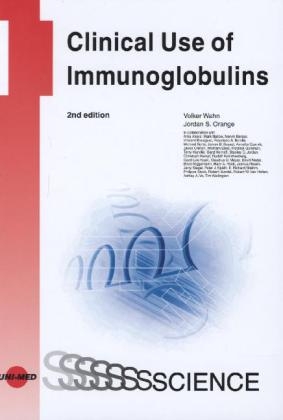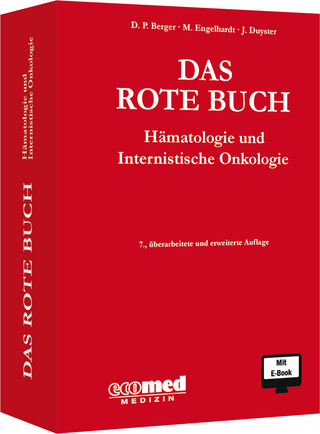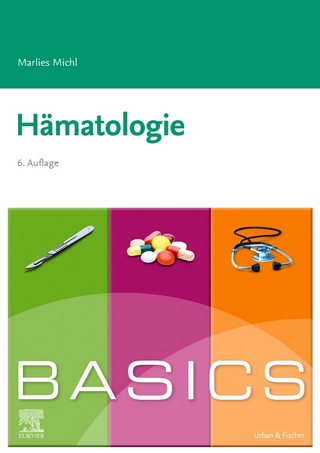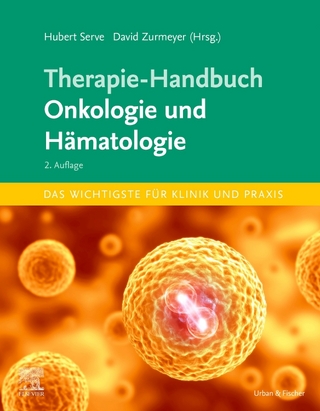Clinical Use of Immunoglobulins
UNI-MED (Verlag)
978-3-8374-1374-8 (ISBN)
- Titel ist leider vergriffen;
keine Neuauflage - Artikel merken
Now five years have passed since the first English edition of “Clinical Use of Immunoglobulins”. Much progress has occurred in the field over that time: new clinical indications, new efficacy and outcome data, novel insights into mechanisms of action and new preparations of therapeutic immunoglobulin.
This new 2nd edition features two entirely new chapters one covering the adverse effects of immunoglobulin therapy (Chapter 3) and a second covering dermatologic diseases (Chapter 16). All previous topics are included and have been updated. In aggregate, the volume provides comprehensive perspective on therapeutic immunoglobulin.
1. The Biology of Antibody Synthesis 22
1.1. Antibodies – the Molecule 23
1.2. Antibodies - Mechanism of Action 24
1.2.1. IgM 25
1.2.2. IgD 26
1.2.3. IgG 26
1.2.4. IgA 26
1.2.5. IgE 27
1.3. The B Cell Repertoire 27
1.4. Peripheral B Cell Activation and Differentiation 28
1.5. Isotype Switching 30
1.6. Conclusion 31
1.7. References 32
2. Pathogen Safety of Immunoglobulin Preparations 33
2.1. Plasma Source 35
2.1.1. Whole Blood or Plasma Donations 35
2.1.2. Selection of Donors and Mass Screening of Donations 35
2.2. Evaluating and Validating the Virus Safety of Immunoglobulin G Preparations 38
2.3. Virus Reduction During Fractionation of Immunoglobulin Preparations 40
2.3.1. Partitioning 40
2.3.2. Inactivation 42
2.3.3. The Introduction of Large-Scale Virus Filtration 43
2.3.4. Additional Virus Reduction and Inactivation Methods 45
2.4. Prion Safety of IVIG/SCIG 45
2.4.1. Measures to Reduce the Theoretical Risk of vCJD Transmission by Immunoglobulin Preparations 46
2.5. Cleaning and Traceability 48
2.5.1. Cleaning of Equipment in Contact with Product Prevent Carryover of Potentially Present Pathogens from Batch to Batch 48
2.5.2. Traceability 48
2.6. Pharmacovigilance, Post-Marketing Studies and Surveillance Programs – the Final Proof of Pathogen Safety of a Blood or Plasma Product 48
2.6.1. Virus Safety 48
2.6.2. The Risk of Transmission of Classic/Sporadic CJD 49
2.6.3. The Risk of Transmission of Variant CJD 49
2.7. Emerging Pathogens 49
2.8. Web-sites worth Reviewing for Additional Information 51
2.9. References 51
3. Adverse Effects of Human Immunoglobulin Therapy 58
3.1. History of Immune Globulin Treatment 58
3.2. Immunoglobulin Products 58
3.3. Reactions to Intramuscular and Subcutaneous Immunoglobulins 58
3.3.1. IGIM Reactions 58
3.3.2. IGSC Reactions 59
3.4. Reactions to Intravenous Immunoglobulin 59
3.5. Types of Reactions 61
3.5.1. Immediate Reactions 61
3.5.2. Delayed Reactions 62
3.6. Summary 65
3.7. References 65
4. Passive Immunoprophylaxis with Immunoglobulins 70
4.1. Definition 70
4.2. General Principles 70
4.3. Specific Immunoglobulin Preparations 70
4.4. Instructions for Use, Side Effects, Contraindications, Interactions 70
4.5. Indications for Passive Immunoprophylaxis 72
4.5.1. Hepatitis A 72
4.5.1.1. Principles 72
4.5.1.2. Passive Immunoprophylaxis 72
4.5.2. Hepatitis B 73
4.5.2.1. Principles 73
4.5.2.2. Passive Immunoprophylaxis 73
4.5.3. Measles 74
4.5.3.1. Principles 74
4.5.3.2. Passive Immunoprophylaxis 74
4.5.4. Rubella 74
4.5.4.1. Principles 74
4.5.4.2. Passive Immunoprophylaxis 74
4.5.5. Varicella 75
4.5.5.1. Principles 75
4.5.5.2. Passive Immunoprophylaxis 75
4.5.6. Cytomegalovirus Infection 76
4.5.6.1. Principles 76
4.5.6.2. Passive Immunoprophylaxis 76
4.6. Monoclonal Antibodies 76
4.6.1. Respiratory Syncytial Virus – Principles 76
4.6.2. Passive Immunoprophylaxis 76
4.7. Bacterial Toxins 77
4.7.1. Botulism 77
4.7.2. Immunoprophylaxis 77
4.7.3. Rabies 77
4.7.4. Diphtheria Toxin 78
4.7.5. Tetanus 78
4.8. References 78
5. Sepsis in Neonates: Prevention and Adjuvant Therapy with Intravenous Immunoglobulin 80
5.1. Immunoglobulin as Prophylaxis in Neonatal Infections 81
5.2. Immunoglobulin as Adjuvant Therapy for Neonatal Infections 84
5.3. Additional Considerations 85
5.4. Recent Developments 86
5.5. Summary 88
5.6. References 89
6. Application of Immunoglobulins in Other Infections 92
6.1. Exacerbation in Cystic Fibrosis 92
6.2. Infection with Respiratory Syncytial Virus 93
6.3. Infection with Rotaviruses 94
6.4. Bacterial Meningitis 94
6.5. Bacterial Sepsis 95
6.6. Streptococcal Toxic Shock-Like Syndrome 95
6.7. Hemolytic Uremic Syndrome 95
6.8. Recurrent Clostridium Difficile Colitis 96
6.9. Infant Botulism 97
6.10. References 97
7. Use of Immunoglobulins in Congenital and Acquired Immunodeficiencies 99
7.1. Definitions 99
7.1.1. Primary Immunodeficiencies with B Cell Defects 99
7.1.2. Secondary Immunodeficiencies with B-Cell Defects 102
7.2. Frequency of Immunodeficiencies 102
7.3. Etiology/Pathogenesis of Immunodeficiencies 102
7.4. Clinical Findings in Humoral Immunodeficiencies 102
7.5. Replacement Therapy with Immunoglobulins 103
7.5.1. Immunoglobulin Therapy for Primary Immunodeficiencies 104
7.5.1.1. Indications of IgG replacement in immunodeficiencies 104
7.5.1.2. Monitoring of Immunoglobulin Therapy 105
7.5.1.3. Infections Despite Immunoglobulin Replacement 105
7.5.1.3.1. Acute Respiratory Infections 105
7.5.1.3.2. Chronic Respiratory Infections 106
7.5.2. Immunoglobulin Therapy for Secondary Immunodeficiencies 106
7.5.2.1. Human Immunodeficiency Virus (HIV) 106
7.6. Summary and Conclusions 106
7.7. References 107
8. IVIG Treatment of Secondary Immune Deficiencies in Adults 109
8.1. Immunity and Infection in Chronic Lymphocytic Leukemia and Multiple Myeloma 109
8.2. Therapy with IVIG in Chronic Lymphocytic Lymphoma and Multiple Myeloma 110
8.3. Hematopoetic Stem Cell Transplantation 112
8.4. References 112
9. Immunomodulation with Immunoglobulins: Mechanisms 114
9.1. Release of Platelets from the Reticuloendothelial System (ITP) 115
9.2. Effects on Platelet-Associated IgG (ITP) 115
9.3. Accelerated Elimination of Circulating and Tissue-Bound Immune Complexes 115
9.4. Interaction with Fc Receptors (FcR) 115
9.5. Inhibition of Cell Adhesion by Natural RGD Antibodies 118
9.6. Effects on the Complement System 118
9.7. Disturbance of (Auto-)Antigen Presentation and Recognition 118
9.8. Interference with the Idiotype-Anti-Idiotype Network (anti-id-Ab) 120
9.9. Effects on Cytokines 120
9.9.1. Neutralization of Inflammatory Cytokines 120
9.9.2. Induction of Regulatory Cytokines and Receptor Antagonists 121
9.9.3. Inhibition of Cellular Responses to Interferon-g by Suppression of Expression of the IFNGR2 Receptor 121
9.9.4. Increased Steroid Mediated Anti-Inflammatory Effects 122
9.10. Neutralization of Superantigens 122
9.11. Effects on Apoptosis 122
9.12. Effects on T cells 123
9.13. Summary 123
9.14. References 123
10. Use of Immunoglobulins in Hematological Cytopenias 127
10.1. Thrombocytopenia 127
10.1.1. Acute Immune Thrombocytopenia 127
10.1.2. Neonatal Alloimmune Thrombocytopenia (AIT) 129
10.1.3. Maternal Autoimmune Thrombocytopenia During Pregnancy 130
10.1.4. Posttransfusion Purpura (PTP) 131
10.1.5. Platelet Transfusions in Marked Alloimmunization 131
10.1.6. Heparin-induced Thrombocytopenia 131
10.1.7. Thrombocytopenia in the Hemolytic-Uremic Syndrome 131
10.1.8. Thrombotic Thrombocytopenic Purpura (Moschcowitz Syndrome) 131
10.1.9. HIV-Associated Thrombocytopenia 132
10.1.10. Chronic ITP 132
10.1.11. SLE-Associated Thrombocytopenia 134
10.1.12. Thrombocytopenia in Primary Antibody Deficiency Syndrome 134
10.2. Immune Hemolytic Anemia 135
10.2.1. Rhesus-Induced Alloimmune Hemolysis 135
10.2.2. ABO Isoimmune Hemolysis 135
10.2.3. Autoimmune Hemolytic Anemia and Evans Syndrome 135
10.3. Bone Marrow Aplasia 136
10.3.1. Erythroid Aplasia, Autoimmune Erythroblastopenia, Pure Red Cell Aplasia (PRCA) 136
10.4. Infection-Associated Hemophagocytosis Syndrome 136
10.5. Immune Neutropenia: Allo- and Autoimmune Neutropenia 137
10.6. Summary 138
10.7. References 138
11. Further Applications of Immunoglobulin Therapy in Pediatric Hematology/Oncology 144
11.1. Polyvalent Immunoglobulin Therapy in Pediatric Oncology Patients Undergoing Chemotherapy 144
11.2. Application of Polyvalent Immunoglobulins in Allogeneic Hematopoietic Stem Cell Transplantation 145
11.3. Application of Polyvalent Immunoglobulins in Hemophilia A/B with Inhibitor 147
11.4. References 147
12. Use of Immunoglobulins in Rheumatologic Disorders and Systemic Autoimmunopathies 150
12.1. Juvenile Idiopathic Arthritis 151
12.2. Rheumatoid Arthritis 154
12.2.1. Felty Syndrome and Macrophage Activation Syndrome (MAS) 154
12.2.2. Systemic Lupus Erythematosus 155
12.3. Antiphospholipid Syndrome (APS) 157
12.4. Scleroderma, Mixed Connective Tissue Disorder 158
12.5. Crohn's Disease and Ulcerative Colitis 159
12.6. Uveitis 160
12.7. Summary and Concluding Remarks 160
12.8. References 161
13. Use of Immunoglobulins for Kawasaki Disease and other Vasculitic Diseases 165
13.1. Kawasaki Disease (KD) 165
13.1.1. Epidemiology and Pathogenesis 165
13.1.2. Clinical Manifestations 166
13.1.3. Efficacy of HDIVIG in the Initial Treatment 167
13.1.4. Time Point of Primary HDIVIG Application 168
13.1.5. Influence of IVIG Preparation on Treatment Efficacy 168
13.1.6. Role of Corticosteroids in the Initial Treatment 168
13.1.7. Second HDIVIG in Patients Non-Responsive to Initial Treatment 169
13.1.8. Steroid Treatment in IVIG-Resistant Patients 169
13.1.9. Alternative Treatment Approaches in IVIG-Resistant Patients 170
13.2. Polyarteritis Nodosa 170
13.3. ANCA-positive Vasculitis [Granulomatosis with Polyangiitis (GPA, Wegener's), Microscopic Polyangiitis) 170
13.4. Churg-Strauss Syndrome 171
13.5. IgA Nephropathy, Henoch-Schoenlein Purpura 172
13.6. Livedo Vasculitis 172
13.7. Vasculitic Complications in Collagen Diseases 172
13.8. Summary 172
13.9. References 173
14. The Use of Immunoglobulins for Neurological Diseases in Children and Adults 177
14.1. Multiple Sclerosis 177
14.2. Epilepsy 179
14.3. Non-Epileptic Encephalopathies in Children and Adolescents 183
14.4. Other CNS Diseases 184
14.5. Paraneoplastic Syndromes 185
14.6. Inflammatory Polyneuropathies 186
14.7. Myasthenia Gravis 193
14.8. Dermatomyositis, Polymyositis, Inclusion Body Myositis 196
14.9. References 198
15. Use of Intravenous Gammaglobulin (IVIG) in Kidney Transplantation 208
15.1. Desensitization for ABO Incompatible Transplantation 208
15.2. Immunomodulation with IVIG: Desensitization of Highly-HLA Sensitized Patients 209
15.2.1. Clinical Use of IVIG in Kidney Transplantation 209
15.2.2. The NIH IGO2 Study 209
15.2.3. Low-dose Intravenous Immunoglobulin and Plasmapheresis 210
15.2.4. IVIG + Rituximab for Desensitization 211
15.2.5. Complications and Cost of IVIG Therapy 211
15.2.6. IVIG and Acute Myocardial Infarction (AMI) 212
15.2.7. IVIG and Acute Renal Failure (ARF) 212
15.2.8. IVIG and Hemolytic Anemia 212
15.2.9. Economic Analysis of IVIG + Rituximab Desensitization Therapy 213
15.3. Adjunctive Therapy 214
15.3.1. Splenectomy and Anti-CD20 214
15.3.2. Kidney Paired Donation 214
15.4. Mechanism of Action of IVIG 215
15.5. Conclusion 216
15.6. References 216
16. The Use of Immunoglobulins for Dermatologic Disease 219
16.1. Pemphigus 219
16.2. Bullous Pemphigoid 222
16.3. Mucous Membrane Pemphigoid 223
16.4. Epidermolysis Bullosa Acquisita 224
16.5. Linear Iga Bullous Disease 224
16.6. Pemphigoid Gestationis 225
16.7. Pyoderma Gangrenosum 226
16.8. Chronic Urticaria 226
16.9. Toxic Epidermal Necrolysis 227
16.10. References 228
17. Use of Immunoglobulins in Allergic Diseases 231
17.1. Bronchial Asthma 231
17.2. Atopic Dermatitis 232
17.3. Chronic Urticaria 233
17.4. Possible Mechanism of Action in Allergic Diseases 233
17.5. References 234
18. Intravenous Immunoglobulin in the Prevention of Recurrent Miscarriage 237
18.1. Studies of IVIG Treatment of RM 237
18.2. Patient Subsets and Treatment Protocols may Determine Outcome of IVIG Studies 238
18.2.1. Patient Subsets 238
18.2.2. Treatment Protocols 239
18.3. Negative Aspects of IVIG Use in RM 239
18.4. Conclusions 240
18.5. References 241
19. Further Indications for Intravenous Immunoglobulins 243
19.1. Graves-Basedow Disease (GBD) / Autoimmune Hyperthyroidism 243
19.2. Bullous Pemphigoid and Pemphigus Vulgaris 243
19.3. Toxic Epidermal Necrolysis (TEN, Lyell's Syndrome) and Stevens-Johnson’s Syndrome 244
19.4. Toxic Shock Syndrome / Necrotising Fasciitis 246
19.5. Myocarditis and Congestive Chronic Heart Failure 246
19.6. Severe Acute Respiratory Syndrome (SARS) 247
19.7. References 247
Index 250
| Erscheint lt. Verlag | 29.6.2013 |
|---|---|
| Reihe/Serie | UNI-MED Science |
| Sprache | englisch |
| Maße | 170 x 240 mm |
| Gewicht | 605 g |
| Einbandart | gebunden |
| Themenwelt | Medizinische Fachgebiete ► Innere Medizin ► Hämatologie |
| Medizin / Pharmazie ► Medizinische Fachgebiete ► Pädiatrie | |
| Schlagworte | Antibody Synthesis • Immunglobulin • Immunglobuline • Pädatrie |
| ISBN-10 | 3-8374-1374-8 / 3837413748 |
| ISBN-13 | 978-3-8374-1374-8 / 9783837413748 |
| Zustand | Neuware |
| Haben Sie eine Frage zum Produkt? |
aus dem Bereich




